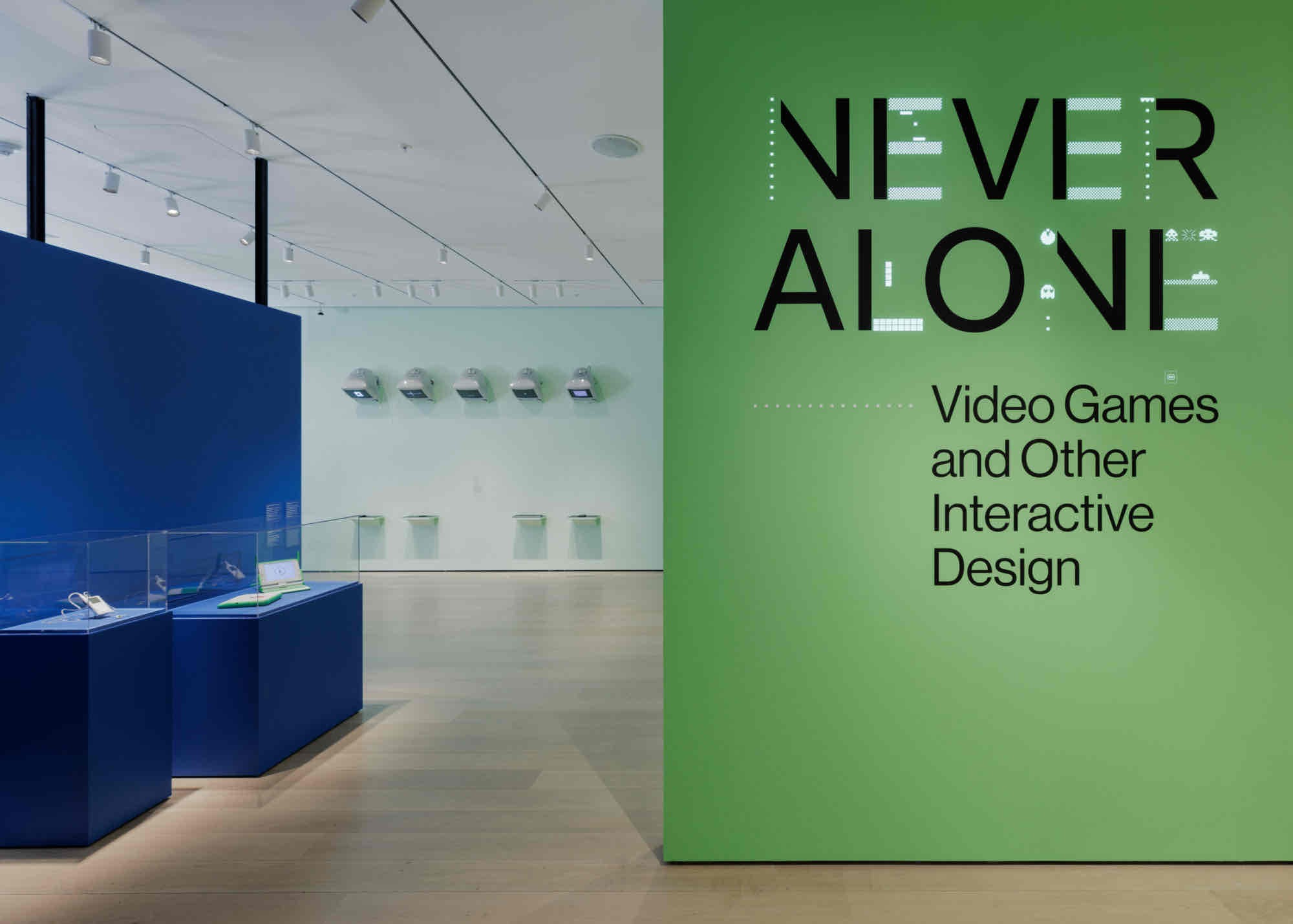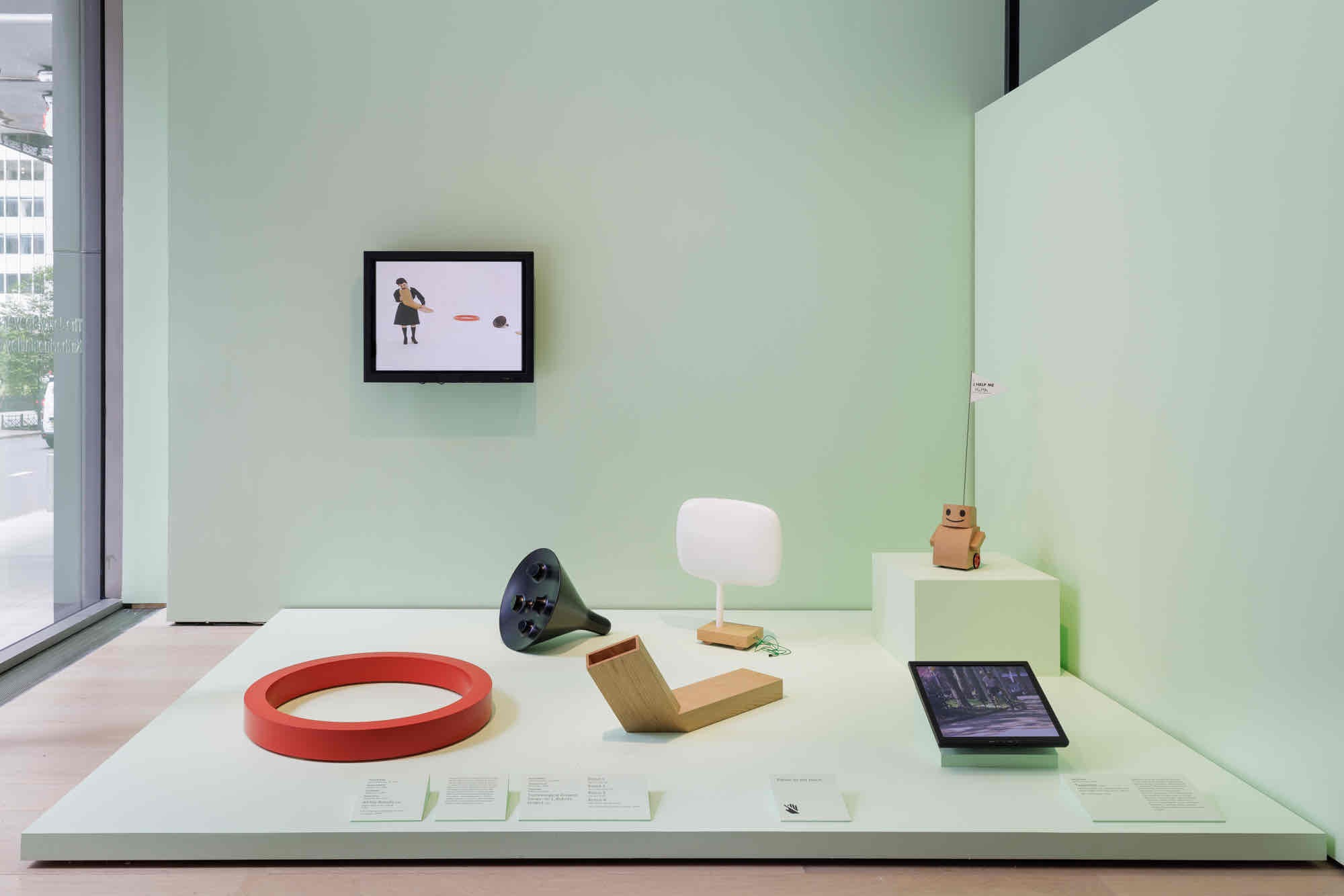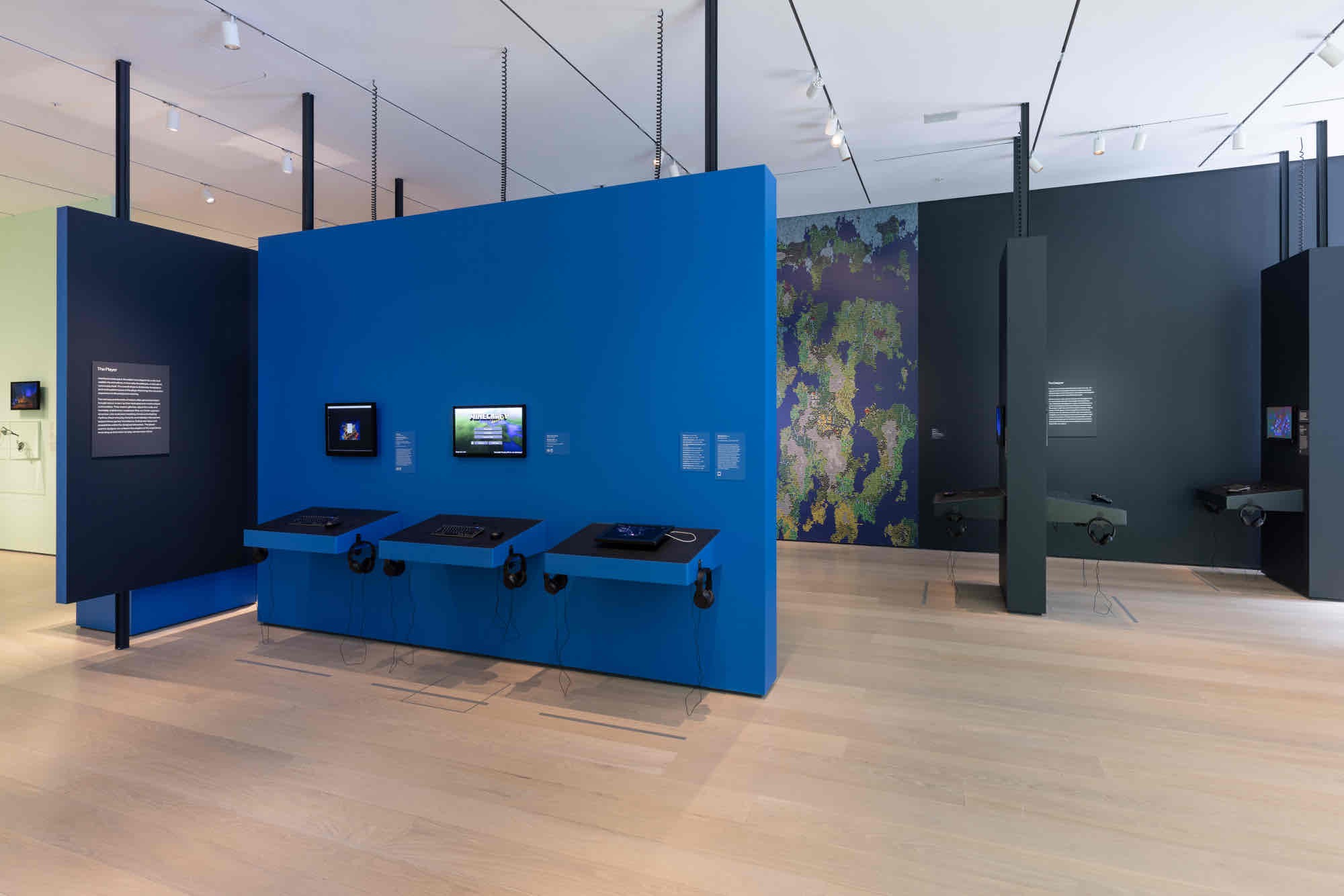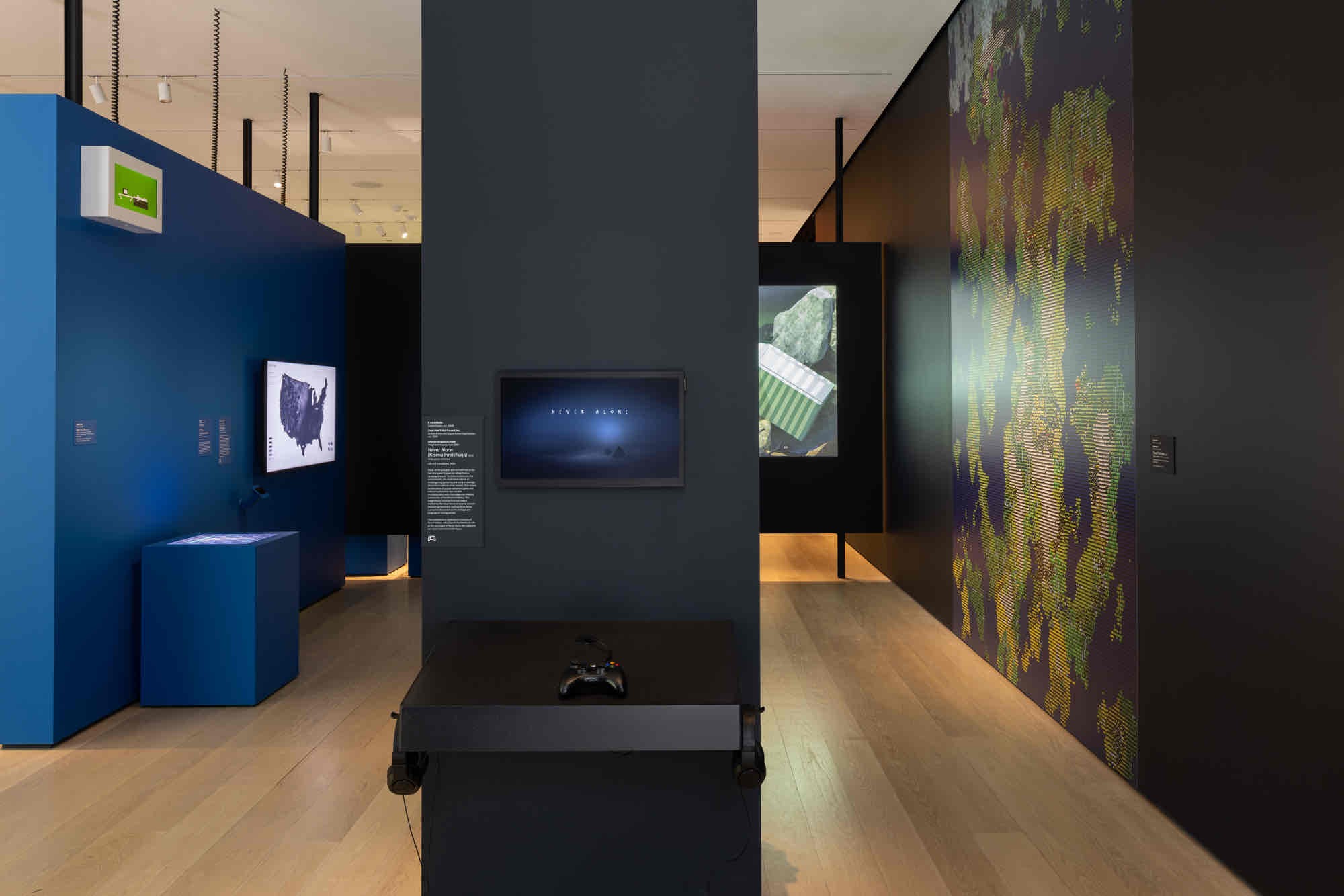Never Alone: Video Games and Other Interactive Design
10 Sep 2022 - 16 Jul 2023

Installation view of Never Alone: Video Games and Other Interactive Design, The Museum of Modern Art, New York, September 10, 2022 – July 16, 2023. © 2022 The Museum of Modern Art. Photo: Emile Askey

Installation view of Never Alone: Video Games and Other Interactive Design, The Museum of Modern Art, New York, September 10, 2022 – July 16, 2023. © 2022 The Museum of Modern Art. Photo: Emile Askey

Installation view of Never Alone: Video Games and Other Interactive Design, The Museum of Modern Art, New York, September 10, 2022 – July 16, 2023. © 2022 The Museum of Modern Art. Photo: Emile Askey

Installation view of Never Alone: Video Games and Other Interactive Design, The Museum of Modern Art, New York, September 10, 2022 – July 16, 2023. © 2022 The Museum of Modern Art. Photo: Emile Askey

Installation view of Never Alone: Video Games and Other Interactive Design, The Museum of Modern Art, New York, September 10, 2022 – July 16, 2023. © 2022 The Museum of Modern Art. Photo: Emile Askey
The Museum of Modern Art announces Never Alone: Video Games and Other Interactive Design, an exhibition that will investigate how interactive design informs the way we move through life and conceive of space, time, and connections, well beyond the game screen. On view in the Museum’s street-level gallery from September 10, 2022, through spring 2023, the exhibition will bring together notable examples of interactive design from MoMA’s collection, including computer interfaces, icons, apps, and 35 video games, 10 of which visitors will be able to play. This exhibition is grounded in the Museum’s history and commitment to collecting interactive design, from 1960s computer terminals to MoMA’s first selection of video games (acquired in 2012) to the websites of today. Never Alone: Video Games and Other Interactive Design is organized by Paola Antonelli, Senior Curator, Paul Galloway, Collection Specialist, and Anna Burckhardt, Curatorial Assistant, Department of Architecture and Design.
“The interfaces we use to access the digital universe are visual and tactile manifestations of code that both connect and separate us, and shape the way we behave and perceive life,” says Paola Antonelli. “Design is all around us, goes the adage, in everything we touch, use, feel, eat. Ever since digital tools have become ubiquitous, interactive design has become the conduit to systems of all kinds, from communication and information to transportation, supply, and more. It is in the touch commands on the screen of an ATM machine or of a smartphone, and in the interface of an ICU monitor. Interactive design
runs a great part of our lives.”
Taking its name from the newly rereleased video game Never Alone (Kisima Inŋgitchuŋa) (2014), the exhibition will be organized into three sections: the Input, the Designer, and the Player. The first section, the Input, will focus on users’ physical interactions with the digital world through tangible objects like keyboards, joysticks, and touchscreens. The second section will examine the Designer’s impact on players’ experiences through early apps like John Maeda’s The Reactive Square (1994) and video games like Lucas Pope’s Papers Please (2014). These first two sections explore different aspects of the interface–where the user meets the machine—making clear that the design of the tangible object and digital experience are fundamental to the success of any interactive design, especially video games. In the third section, the exhibition will explore how the Player’s performance, choices, and interpretation define and reshape games and apps. Video games such as SimCity 2000 (1993) and Minecraft (2011) will be on view as examples of how players can create their own personalized worlds. These works demonstrate that a great part of the success of a game might depend on the player, not only on the designer.
The objects, interfaces, icons, and video games featured in this exhibition were selected as trailblazing examples of interactive design. The criteria for selecting video games were based not only on the aesthetic and narrative quality of each, but also on many other aspects—from the elegance of the code to the choreography of the player’s behavior—that pertain to interactive design. The criteria also focus on how the digital space is designed, flows, and morphs in time; how the game receives and conveys instructions and information via screens and input devices; and how a person interacts with them, whether digitally or physically.
The accompanying publication, Never Alone: Video Games as Interactive Design, written by Paola Antonelli, Anna Burckhardt, and Paul Galloway, explores the impact of interactive design by examining 35 video games created between 1972 and 2018—from Space Invaders (1978) and Pac-Man (1980) to The Sims (2000) and Minecraft. An overarching essay presents the pioneering criteria by which MoMA has selected these video games for its collection, as well as the protocols for their acquisition, display, and conservation. The richly illustrated plate section is divided into three sections that analyze input devices, game designers, and players.
Senior Curator: Paola Antonelli
“The interfaces we use to access the digital universe are visual and tactile manifestations of code that both connect and separate us, and shape the way we behave and perceive life,” says Paola Antonelli. “Design is all around us, goes the adage, in everything we touch, use, feel, eat. Ever since digital tools have become ubiquitous, interactive design has become the conduit to systems of all kinds, from communication and information to transportation, supply, and more. It is in the touch commands on the screen of an ATM machine or of a smartphone, and in the interface of an ICU monitor. Interactive design
runs a great part of our lives.”
Taking its name from the newly rereleased video game Never Alone (Kisima Inŋgitchuŋa) (2014), the exhibition will be organized into three sections: the Input, the Designer, and the Player. The first section, the Input, will focus on users’ physical interactions with the digital world through tangible objects like keyboards, joysticks, and touchscreens. The second section will examine the Designer’s impact on players’ experiences through early apps like John Maeda’s The Reactive Square (1994) and video games like Lucas Pope’s Papers Please (2014). These first two sections explore different aspects of the interface–where the user meets the machine—making clear that the design of the tangible object and digital experience are fundamental to the success of any interactive design, especially video games. In the third section, the exhibition will explore how the Player’s performance, choices, and interpretation define and reshape games and apps. Video games such as SimCity 2000 (1993) and Minecraft (2011) will be on view as examples of how players can create their own personalized worlds. These works demonstrate that a great part of the success of a game might depend on the player, not only on the designer.
The objects, interfaces, icons, and video games featured in this exhibition were selected as trailblazing examples of interactive design. The criteria for selecting video games were based not only on the aesthetic and narrative quality of each, but also on many other aspects—from the elegance of the code to the choreography of the player’s behavior—that pertain to interactive design. The criteria also focus on how the digital space is designed, flows, and morphs in time; how the game receives and conveys instructions and information via screens and input devices; and how a person interacts with them, whether digitally or physically.
The accompanying publication, Never Alone: Video Games as Interactive Design, written by Paola Antonelli, Anna Burckhardt, and Paul Galloway, explores the impact of interactive design by examining 35 video games created between 1972 and 2018—from Space Invaders (1978) and Pac-Man (1980) to The Sims (2000) and Minecraft. An overarching essay presents the pioneering criteria by which MoMA has selected these video games for its collection, as well as the protocols for their acquisition, display, and conservation. The richly illustrated plate section is divided into three sections that analyze input devices, game designers, and players.
Senior Curator: Paola Antonelli
